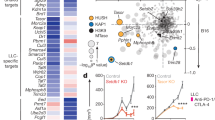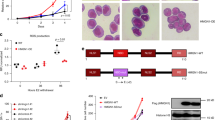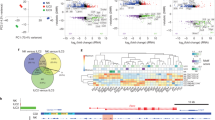Abstract
The major histocompatibility complex class II (MHC-II) locus encodes a cluster of highly polymorphic genes HLA-DR, -DQ and -DP that are co-expressed in mature B lymphocytes. Two cell lines were established over 30 years ago from a patient diagnosed with acute lymphocytic leukemia. Laz221 represented the leukemic cells of the patient; whereas Laz388 represented the normal B cells of the patient. Although Laz388 expressed both HLA-DR and HLA-DQ surface and gene products, Laz221 expressed only HLA-DR genes. The discordant expression of HLA-DR and HLA-DQ genes was due to epigenetic silencing of the HLA-DQ region CCCTC transcription factor (CTCF)-binding insulators that separate the MHC-II sub-regions by DNA methylation. These epigenetic modifications resulted in the loss of binding of the insulator protein CTCF to the HLA-DQ flanking insulator regions and the MHC-II-specific transcription factors to the HLA-DQ promoter regions. These events led to the inability of the HLA-DQ promoter regions to interact with flanking insulators that control HLA-DQ expression. Inhibition of DNA methylation by treatment with 5′-deoxyazacytidine reversed each of these changes and restored expression of the HLA-DQ locus. These results highlight the consequence of disrupting an insulator within the MHC-II region and may be a normal developmental mechanism or one used by tumor cells to escape immune surveillance.
This is a preview of subscription content, access via your institution
Access options
Subscribe to this journal
Receive 6 digital issues and online access to articles
$119.00 per year
only $19.83 per issue
Buy this article
- Purchase on Springer Link
- Instant access to full article PDF
Prices may be subject to local taxes which are calculated during checkout







Similar content being viewed by others
References
Germain RN, Braunstein NS, Brown MA, Glimcher LH, Lechler RI, McCluskey J et al. Structure and function of murine class II major histocompatibility complex genes. Mt Sinai J Med 1986; 53: 194–201.
Sloan VS, Cameron P, Porter G, Gammon M, Amaya M, Mellins E et al. Mediation by HLA-DM of dissociation of peptides from HLA-DR. Nature 1995; 375: 802–806.
Weber DA, Evavold BD, Jensen PE . Enhanced dissociation of HLA-DR-bound peptides in the presence of HLA-DM. Science 1996; 274: 618–620.
Ting JP, Trowsdale J . Genetic control of MHC class II expression. Cell 2002; 109 (Suppl): S21–S33.
Reith W, Mach B . The bare lymphocyte syndrome and the regulation of MHC expression. Annu Rev Immunol 2001; 19: 331–373.
Boss JM, Jensen PE . Transcriptional regulation of the MHC class II antigen presentation pathway. Curr Opin Immunol 2003; 15: 105–111.
Masternak K, Muhlethaler-Mottet A, Villard J, Zufferey M, Steimle V, Reith W . CIITA is a transcriptional coactivator that is recruited to MHC class II promoters by multiple synergistic interactions with an enhanceosome complex. Genes Dev 2000; 14: 1156–1166.
Beresford GW, Boss JM . CIITA coordinates multiple histone acetylation modifications at the HLA-DRA promoter. Nat Immunol 2001; 2: 652–657.
Boss JM . Regulation of transcription of MHC class II genes. Curr Opin Immunol 1997; 9: 107–113.
Mach B, Steimle V, Martinez-Soria E, Reith W . Regulation of MHC class II genes: lessons from a disease. Annu Rev Immunol 1996; 14: 301–331.
Steimle V, Siegrist CA, Mottet A, Lisowska-Grospierre B, Mach B . Regulation of MHC class II expression by interferon-gamma mediated by the transactivator gene CIITA. Science 1994; 265: 106–109.
Majumder P, Gomez JA, Boss JM . The human major histocompatibility complex class II HLA-DRB1 and HLA-DQA1 genes are separated by a CTCF-binding enhancer-blocking element. J Biol Chem 2006; 281: 18435–18443.
Masternak K, Peyraud N, Krawczyk M, Barras E, Reith W . Chromatin remodeling and extragenic transcription at the MHC class II locus control region. Nat Immunol 2003; 4: 132–137.
Gomez JA, Majumder P, Nagarajan UM, Boss JM . X box-like sequences in the MHC class II region maintain regulatory function. J Immunol 2005; 175: 1030–1040.
Majumder P, Boss JM . CTCF controls the expression and the chromatin architecture of the human major histocompatibility complex class II locus. Mol Cell Biol 2010; 30: 4211–4223.
Bell AC, Felsenfeld G . Methylation of a CTCF-dependent boundary controls imprinted expression of the Igf2 gene. Nature 2000; 405: 482–485.
Rodriguez C, Borgel J, Court F, Cathala G, Forne T, Piette J . CTCF is a DNA methylation-sensitive positive regulator of the INK/ARF locus. Biochem Biophys Res Commun 2010; 392: 129–134.
West AG, Huang S, Gaszner M, Litt MD, Felsenfeld G . Recruitment of histone modifications by USF proteins at a vertebrate barrier element. Mol Cell 2004; 16: 453–463.
Labrador M, Corces VG . Setting the boundaries of chromatin domains and nuclear organization. Cell 2002; 111: 151–154.
Bushey AM, Dorman ER, Corces VG . Chromatin insulators: regulatory mechanisms and epigenetic inheritance. Mol Cell 2008; 32: 1–9.
Farrell CM, Grinberg A, Huang SP, Chen D, Pichel JG, Westphal H et al. A large upstream region is not necessary for gene expression or hypersensitive site formation at the mouse beta -globin locus. Proc Natl Acad Sci USA 2000; 97: 14554–14559.
Majumder P, Gomez JA, Chadwick BP, Boss JM . The insulator factor CTCF controls MHC class II gene expression and is required for the formation of long-distance chromatin interactions. J Exp Med 2008; 205: 785–798.
Lazarus H, Barell EF, Krishan A, Livingston DM, Harris K, Schlossman SF et al. Characterization if a unique cell line (Laz221) from human acute lymphocytic (“null” cell) leukemia. Cancer Res 1978; 38: 1362–1367.
Woolfrey AE, Andersen LC, Shewey L, Chung J, Nepom GT . Analysis of differential HLA-DQB expression in autologous B cell lines. J Leukoc Biol 1993; 53: 697–706.
Pesando JM, Graf L . Differential expression of HLA-DR, -DQ, and -DP antigens on malignant B cells. J Immunol 1986; 136: 4311–4318.
Hercend T, Meuer S, Reinherz EL, Schlossman SF, Ritz J . Generation of a cloned NK cell line derived from the “null cell” fraction of human peripheral blood. J Immunol 1982; 129: 1299–1305.
Woolfrey AE, Nepom GT . Differential transcription elements direct expression of HLA-DQ genes. Clin Immunol Immunopathol 1995; 74: 119–126.
Moreno CS, Rogers EM, Brown JA, Boss JM . Regulatory factor X, a bare lymphocyte syndrome transcription factor, is a multimeric phosphoprotein complex. J Immunol 1997; 158: 5841–5848.
Weber M, Davies JJ, Wittig D, Oakeley EJ, Haase M, Lam WL et al. Chromosome-wide and promoter-specific analyses identify sites of differential DNA methylation in normal and transformed human cells. Nat Genet 2005; 37: 853–862.
Tolhuis B, Palstra RJ, Splinter E, Grosveld F, de Laat W . Looping and interaction between hypersensitive sites in the active beta-globin locus. Mol Cell 2002; 10: 1453–1465.
Renda M, Baglivo I, Burgess-Beusse B, Esposito S, Fattorusso R, Felsenfeld G et al. Critical DNA binding interactions of the insulator protein CTCF: a small number of zinc fingers mediate strong binding, and a single finger-DNA interaction controls binding at imprinted loci. J Biol Chem 2007; 282: 33336–33345.
Spektor TM, Rice JC . Identification and characterization of posttranslational modification-specific binding proteins in vivo by mammalian tethered catalysis. Proc Natl Acad Sci USA 2009; 106: 14808–14813.
Jones PA, Liang G . Rethinking how DNA methylation patterns are maintained. Nat Rev 2009; 10: 805–811.
Patel K, Dickson J, Din S, Macleod K, Jodrell D, Ramsahoye B . Targeting of 5-aza-2′-deoxycytidine residues by chromatin-associated DNMT1 induces proteasomal degradation of the free enzyme. Nucleic Acids Res 2010; 38: 4313–4324.
Taylor S, Jones P . Mechanism of action of eukaryotic DNA methyltransferase *1: Use of 5-azacytosine-containing DNA. J Mol Biol 1982; 162: 679–692.
Steimle V, Durand B, Barras E, Zufferey M, Hadam MR, Mach B et al. A novel DNA-binding regulatory factor is mutated in primary MHC class II deficiency (bare lymphocyte syndrome). Genes Dev 1995; 9: 1021–1032.
Nagarajan UM, Peijnenburg A, Gobin SJ, Boss JM, van den elsen PJ . Novel mutations within the RFX-B gene and partial rescue of MHC and related genes through exogenous class II transactivator in RFX-B-deficient cells. J Immunol 2000; 164: 3666–3674.
Kara CJ, Glimcher LH . In vivo footprinting of MHC class II genes: bare promoters in the bare lymphocyte syndrome. Science 1991; 252: 709–712.
Dialynas GK, Vitalini MW, Wallrath LL . Linking heterochromatin protein 1 (HP1) to cancer progression. Mutat Res 2008; 647: 13–20.
Fischle W, Tseng BS, Dormann HL, Ueberheide BM, Garcia BA, Shabanowitz J et al. Regulation of HP1-chromatin binding by histone H3 methylation and phosphorylation. Nature 2005; 438: 1116–1122.
West AG, Gaszner M, Felsenfeld G . Insulators: many functions, many mechanisms. Genes Dev 2002; 16: 271–288.
Dickson J, Gowher H, Strogantsev R, Gaszner M, Hair A, Felsenfeld G et al. VEZF1 elements mediate protection from DNA methylation. PLoS Genet 2010; 6: e1000804.
Reitz Jr MS, Mann DL, Eiden M, Trainor CD, Clarke MF . DNA methylation and expression of HLA-DR alpha. Mol Cell Biol 1984; 4: 890–897.
Carrington MN, Salter RD, Cresswell P, Ting JP . Evidence for methylation as a regulatory mechanism in HLA-DR alpha gene expression. Immunogenetics 1985; 22: 219–229.
Toyoda H, Redford A, Magalong D . Allele-specific methylation in the 5′-regulatory region of class II DQ beta genes in the human major histocompatibility complex (MHC): relationship to autoimmune disease susceptibility. Dis Markers 1992; 10: 7–18.
Edwards JA, Durant BM, Jones DB, Evans PR, Smith JL . Differential expression of HLA class II antigens in fetal human spleen: relationship of HLA-DP, DQ, and DR to immunoglobulin expression. J Immunol 1986; 137: 490–497.
Falkenburg JH, Fibbe WE, Goselink HM, Van Rood JJ, Jansen J . Human hematopoietic progenitor cells in long-term cultures express HLA-DR antigens and lack HLA-DQ antigens. J Exp Med 1985; 162: 1359–1369.
Linch DC, Nadler LM, Luther EA, Lipton JM . Discordant expression of human Ia-like antigens on hematopoietic progenitor cells. J Immunol 1984; 132: 2324–2329.
Suarez-Alvarez B, Rodriguez RM, Calvanese V, Blanco-Gelaz MA, Suhr ST, Ortega F et al. Epigenetic mechanisms regulate MHC and antigen processing molecules in human embryonic and induced pluripotent stem cells. PloS One 2010; 5: e10192.
Cycon KA, Rimsza LM, Murphy SP . Alterations in CIITA constitute a common mechanism accounting for downregulation of MHC class II expression in diffuse large B-cell lymphoma (DLBCL). Exp Hematol 2009; 37: 184–194.
Rimsza LM, Roberts RA, Miller TP, Unger JM, LeBlanc M, Braziel RM et al. Loss of MHC class II gene and protein expression in diffuse large B-cell lymphoma is related to decreased tumor immunosurveillance and poor patient survival regardless of other prognostic factors: a follow-up study from the Leukemia and Lymphoma Molecular Profiling Project. Blood 2004; 103: 4251–4258.
Wilkinson ST, Fernandez DR, Murphy SP, Braziel RM, Campo E, Chan WC et al. Decreased major histocompatibility complex class II expression in diffuse large B-cell lymphoma does not correlate with CpG methylation of class II transactivator promoters III and IV. Leuk Lymphoma 2009; 50: 1875–1878.
Rimsza LM, Chan WC, Gascoyne RD, Campo E, Jaffe ES, Staudt LM et al. CIITA or RFX coding region loss of function mutations occur rarely in diffuse large B-cell lymphoma cases and cell lines with low levels of major histocompatibility complex class II expression. Haematologica 2009; 94: 596–598.
Acknowledgements
We thank Dr C Scharer for aiding with the development of the MeDIP assay and his comments of the work. We thank and acknowledge the technical support for this project from Royce Butler. This work was supported by NIH grant GM47310.
Author information
Authors and Affiliations
Corresponding author
Ethics declarations
Competing interests
The authors declare no conflict of interest.
Additional information
Supplementary Information accompanies the paper on Genes and Immunity website
Rights and permissions
About this article
Cite this article
Majumder, P., Boss, J. DNA methylation dysregulates and silences the HLA-DQ locus by altering chromatin architecture. Genes Immun 12, 291–299 (2011). https://doi.org/10.1038/gene.2010.77
Received:
Revised:
Accepted:
Published:
Issue Date:
DOI: https://doi.org/10.1038/gene.2010.77
Keywords
This article is cited by
-
DNA methylation as a mediator of HLA-DRB1*15:01 and a protective variant in multiple sclerosis
Nature Communications (2018)
-
Transancestral mapping and genetic load in systemic lupus erythematosus
Nature Communications (2017)
-
The intellectual disability of trisomy 21: differences in gene expression in a case series of patients with lower and higher IQ
European Journal of Human Genetics (2013)
-
Expression of the Epigenetic factor BORIS (CTCFL) in the Human Genome
Journal of Translational Medicine (2011)



